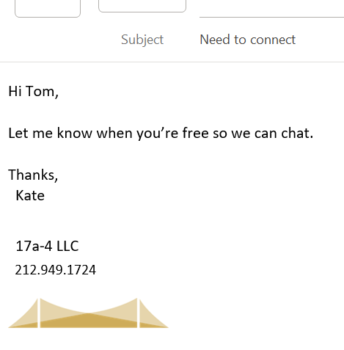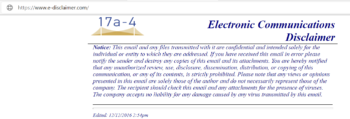The language in email disclaimers will often cause issues with compliance polices and procedures so hyperlinks have emerged as the go-to solution. Of course, maintaining the linked content is the key to preserving the legally defensible disclaimer and mitigating risk.
Prospectuses and other disclosure documents present similar risks. What used to be a printed document is now provided as a link in an email to customers. When that prospectus language changes, the link remains the same but each version of the prospectus must be maintained to provide legal defense.
Our solution eliminates these issues and offers the following features:
Virtually all financial institutions attach disclaimers to outgoing email but managing these disclaimers creates significant issues.
eDisclaimer eliminates these issues and ensures compliance.

eDisclaimer is our hyperlinked email disclaimer service that:
Each sent email will contain your custom hyperlink.

![]()
The linked URL has the disclaimer language, timestamp and is fully customizable including logos and fonts.

Providing electronic versions of prospectuses, disclosures, and offering documents provides significant savings in printing and distribution costs to the financial industry, it also represents risk. Most use links to prospectuses or other disclosure documents that do not generate a hash or other admissible evidence as to the exact text referenced by the hyperlink. Instead they use a generic link for all past versions which means that there is no clear ‘chain-of-custody’ if used as evidence in a regulatory or legal matter.
eProspectus protects the ‘chain-of-custody’ by preserving the text, content, language, time/date and other metadata of each variation of the document. The versions are stored and maintained for any future legal matter and, if needed, our compliance officers are able to testify to specific versions in question.
Regulations insist that institutions attach a disclaimer to all corporate emails. Email disclaimers are necessary to protect rights and responsibilities of a firm but can prove burdensome to Compliance and IT. This is especially true when time is of the essence in response to an SEC or FINRA regulatory request for an e-discovery production.
The language of a legal disclaimers, words like confidential, privacy, guarantee etc., are necessary for the intended protections and to comply with governing laws and regulations. However, these exact words and terms are often included in lexicons used to monitor bad behavior or nefarious business practice. So endless amounts of emails can be unnecessarily flagged by regulatory supervisory systems (FINRA Rule 3110 and IAA 203). These data exports are then sent to outside counsel for culling thus increasing costs of legal reviews and e-discovery productions.
All this flagged content is being archived along with the email’s full text. The result was a large amount of usable archive space occupied by inconsequential content at a considerable cost. Full text email disclaimers can account for as much as 15% of space in an institutions archive. A hyperlinked solution simply eliminates the flagging and retention of these items in the archive.
Many institutions require multiple disclaimers due to departmental requirements and international corporate laws. Disclaimers must fit applicable government regulations and contain appropriate language. The organization must also provide the testimony of authentication and the verification of the “chain of custody”. In short, what disclaimer was used when.
17a-4’s eDisclaimer addresses the legal and regulatory requirements for implementing hyperlinked email disclaimers, specifically the defensible authentication of the linked connection. Most hyperlinked disclaimers being used in corporate email cannot provide the required authentication and, as a result, are not legally enforceable. If an organization simply deploys a hyperlink to a webpage with a full disclaimer, they have failed to authenticate the connection and are not legally defended. There is no verifiable proof that, at the time of the email, the specific disclaimer was valid and linked. The legality of the disclaimer is negated unless each email can be proven to connect to a specific e-disclaimer, as it reads at the time of attachment.
17a-4’s eDisclaimer proves the integrity of the hyperlink by managing a repository on behalf of clients. The repository contains all disclaimers used by an institution, including multi-lingual and conditional variations such as e-messaging and social networking disclaimers.